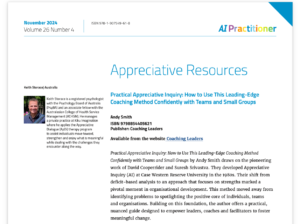How the ‘Experience Cube’ Works in Coaching (4

[ad_1]

This article follows on from previous articles considering the other quadrants of the Experience Cube: Observations, Thoughts, Emotions, and (obviously) Wants part 1 – so you might want to read those first. The Experience Cube is a model from Gervase Bushe’s excellent book Clear Leadership: Sustaining Real Collaboration and Partnership at Work
If They Want It, But They Don’t Think They Can Get There
What if the client believes that what they want is beyond their ability to achieve? This could be a product of their belief system rather than of objective facts, and there are a number of ways we could address this.
I’m going to leave the traditional coaching question “What stops you?” as a last resort, because it focuses on obstacles and so risks tipping the client back into ‘Task Positive’ or ‘analytic’ mode (or embedding them deeper in that mindset if it’s already activated), which will shut down their creativity and openness to new ideas. Luckily there are some more appreciative and solution-focused ways of exploring, dismantling, or routing round limiting beliefs that we can use.
Backward Chaining
One way that we can explore possible routes to a goal is by inviting the client to imagine that the goal has already been achieved, and working backwards from there. We can do this by asking about the conditions that would need to be in place in order for their desired solution to be possible: “What would have to be in place in order for that to happen? What else would need to be in place? Anything else?” (you could use that final ‘closed’ question when it feels like you’re getting to the end of their list of conditions).
For each of the conditions identified above, you could ask “And what conditions would need to be in place for that to happen?”, and so on. It’s possible that this may uncover multiple possible pathways to the desired outcome, and some of those conditions may be in place already.
What you’re doing here is known as ‘backward chaining’ (according to Jonathan Altfeld’s Genius Mapping method, which is where I first learned about it). You’re tracing the chain of causality all the way back to where the client is now, which should help them to find their first step on the way to getting there.
It may be that there are obstacles to the client achieving what they want, whether these are internalised beliefs (which in principle we may be able to help them change), or external barriers (which they may be able to find ways round).
What Would Happen If You Did?
A simple question you could ask if the client indicates doubt that they can achieve what they want is, “What would happen if you did?” The question invites them to jump past the obstacles, step into the possibility, and explore it in more detail, rather than just viewing it at a distance and crossing it off as an option. They will then have more information about the possibility to base their decisions on.
Scaling Questions
Scaling questions such as these can be useful: “On a scale of 0-10, where 0 is not at all and 10 is totally, how much do you want this?” or “How enthusiastic do you feel about this, on a scale of 1-10?”
We’re looking for a ‘10’ here. If the coaching client answers with anything less, it may indicate some downside to the desired outcome, possibly even one that’s just a vague sentiment rather than something they are consciously aware of. In this situation you could follow up with, “What would have to be different to get that up to 10?”
This gives the client an opportunity to adjust their vision of the desired future to get rid of the anticipated downsides.
Break The Journey Down
What if the client really wants the goal, but it’s the means of getting there, or the effort they expect will be entailed, that is putting them off? ‘Backward chaining’ as outlined above could help them find an alternative route, or you could help them break down the task of getting there into smaller steps, until each step feels more achievable.
I’m starting a new Practical Appreciative Inquiry facilitator training soon. If you like my materials and the way I approach things, this is pretty much the only training I’m doing these days – and it gives you a great method for coaching teams and small groups!
“Andy’s class on practical appreciative inquiry was exactly what I was looking for. His content is rich and excellent and speaks right to the hearts and minds of facilitators in the business world and community. I highly recommend this course to anyone interested in working with leaders on this brilliant model” – Brenda Abdilla, Executive Coach & Author | Speaker & Facilitator| Assessments Expert | Founder of The Entourage Leadership Group for Women | Chapter Chair Denver WPO (see this testimonial plus many others from course graduates in the ‘Recommendations’ section of my LinkedIn profile)
[ad_2]




